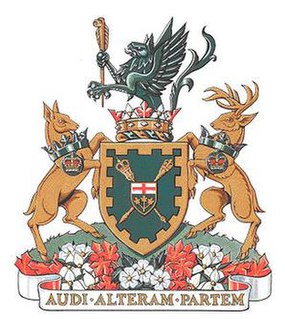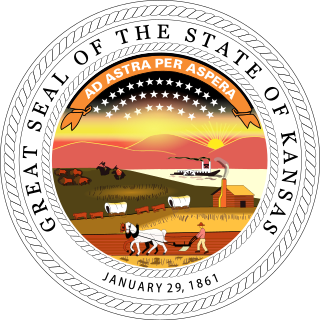
The Seventeenth Amendment to the United States Constitution established the popular election of United States Senators by the people of the states. The amendment supersedes Article I, §3, Clauses 1 and 2 of the Constitution, under which senators were elected by state legislatures. It also alters the procedure for filling vacancies in the Senate, allowing for state legislatures to permit their governors to make temporary appointments until a special election can be held.

The Minnesota House of Representatives is the lower house of the Legislature of the U.S. state of Minnesota. There are 134 members, exactly twice as many as the Minnesota Senate. Floor sessions are held in the north wing of the State Capitol in Saint Paul. Offices for members and staff, as well as most committee hearings, are located in the nearby State Office Building.

The North Carolina General Assembly is the bicameral legislature of the State government of North Carolina. The legislature consists of two chambers: the Senate and the House of Representatives. The General Assembly meets in the North Carolina Legislative Building in Raleigh, North Carolina, United States.

The Legislative Assembly of Ontario is one of two components of the Legislature of Ontario, the other being the Lieutenant Governor of Ontario. The Legislative Assembly is the second largest Canadian provincial deliberative assembly by number of members after the National Assembly of Quebec. The Assembly meets at the Ontario Legislative Building at Queen's Park in the provincial capital of Toronto.

The Legislative Assembly of Alberta is one of two components of the Legislature of Alberta, the other being Elizabeth II, Queen of Canada, represented by the Lieutenant-Governor of Alberta. The Alberta legislature meets in the Alberta Legislature Building in the provincial capital, Edmonton. The Legislative Assembly consists of 87 members, elected first past the post from single-member electoral districts.

The Kansas Legislature is the state legislature of the U.S. state of Kansas. It is a bicameral assembly, composed of the lower Kansas House of Representatives, with 125 state representatives, and the upper Kansas Senate, with 40 state senators. Representatives are elected for two-year terms, senators for four-year terms.

The National Popular Vote Interstate Compact (NPVIC) is an agreement among a group of U.S. states and the District of Columbia to award all their electoral votes to whichever presidential candidate wins the overall popular vote in the 50 states and the District of Columbia. The compact is designed to ensure that the candidate who receives the most votes nationwide is elected president, and it would come into effect only when it would guarantee that outcome. As of March 2019, it has been adopted by thirteen states and the District of Columbia. Together, they have 184 electoral votes, which is 34.2% of the Electoral College and 68.1% of the 270 votes needed to give the compact legal force.

The 1830 general election organized the first legislature of the July Monarchy but was meant to organize the sixth legislature of the Bourbon Restoration. The election was held on 5 and 13 July, with the second round held on 19 July.

The 2010 United States elections were held on Tuesday, November 2, 2010, in the middle of Democratic President Barack Obama's first term. During this midterm election year, all 435 seats in the United States House of Representatives and 37 of the 100 seats in the United States Senate were contested, along with 39 state and territorial governorships, 46 state legislatures, four territorial legislatures and numerous state and local offices. Approximately 82.5 million people voted.

In the United States, a state is a constituent political entity, of which there are currently 50. Bound together in a political union, each state holds governmental jurisdiction over a separate and defined geographic territory and shares its sovereignty with the federal government. Due to this shared sovereignty, Americans are citizens both of the federal republic and of the state in which they reside. State citizenship and residency are flexible, and no government approval is required to move between states, except for persons restricted by certain types of court orders. Four states use the term commonwealth rather than state in their full official names.

The Tamil Nadu Legislative Assembly alone has powers to legislate laws covering state subjects in the Indian state of Tamil Nadu. It has a strength of 235 members of whom 234 are democratically elected using the First-past-the-post system. The remaining member is nominated as a representative of the Anglo-Indian community. The presiding officer of the Assembly is called the Speaker. The term of the Assembly is five years unless it is dissolved earlier.
The 1789 United States Senate election in New York was held in July 1789 to elect two U.S. Senators to represent the State of New York in the United States Senate. It was the first such election, and before the actual election the New York State Legislature had to establish the proceedings how to elect the senators.

The United States Senate elections of 1788 and 1789 were the first elections for the United States Senate, which coincided with the election of President George Washington. As of this election, formal organized political parties had yet to form in the United States, but two political factions were present: The coalition of senators who supported George Washington's administration were known as "Pro-Administration," and the senators against him as "Anti-Administration."
An Election to the United States House of Representatives in Pennsylvania were held on November 26, 1788 for the 1st Congress.

The 176th New York State Legislature, consisting of the New York State Senate and the New York State Assembly, met from January 5 to July 6, 1966, during the eighth year of Nelson Rockefeller's governorship, in Albany.

The 181st New York State Legislature, consisting of the New York State Senate and the New York State Assembly, met from January 8, 1975, to August 5, 1976, during the first and second years of Hugh Carey's governorship in Albany.

The 184th New York State Legislature, consisting of the New York State Senate and the New York State Assembly, met from January 7, 1981, to December 31, 1982, during the seventh and eighth years of Hugh Carey's governorship, in Albany.

The 1792 United States presidential election in New York took place between November 2 and December 5, 1792 as part of the 1792 United States presidential election. The state legislature chose 12 representatives, or electors to the Electoral College, who voted for President and Vice President.

The 197th New York State Legislature, consisting of the New York State Senate and the New York State Assembly, met from January 3, 2007, to December 31, 2008, during Eliot Spitzer's and the early part of David Paterson's governorship, in Albany.

















